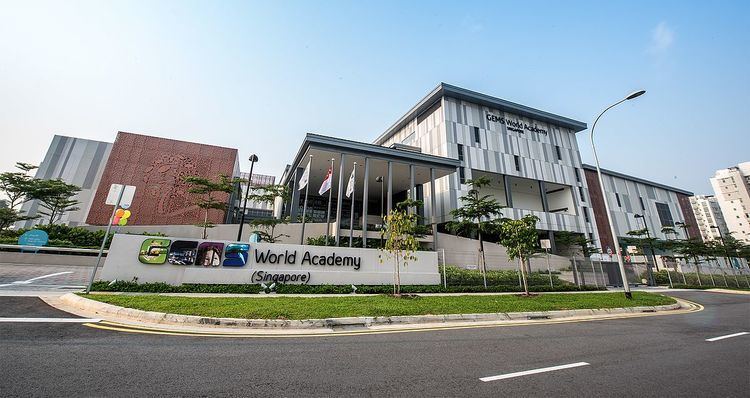 | ||
An international school is a school that promotes international education, in an international environment, either by adopting a curriculum such as that of the International Baccalaureate, Edexcel or Cambridge International Examinations, or by following a national curriculum different from that of the school's country of residence.
Contents
Overview
These schools cater mainly to students who are not nationals of the host country, such as the children of the staff of international businesses, international organizations, foreign embassies, missions, or missionary programs. Many local students attend these schools to learn the language of the international school and to obtain qualifications for employment or higher education in a foreign country.
History
The first international schools were founded in the latter half of the 19th century in countries such as Japan, Switzerland and Turkey. Early international schools were set up for families who traveled, like children of personnel of international companies, international organizations, non-governmental organizations (NGO), and embassy staff. The schools were established with the people and organizations having large interests in the hosting nation: for instance, American diplomats and missionaries often set up schools to educate their children; children of American military and army families often attended Department of Defense Dependents Schools (DoDDS); French diplomats and business families founded similar schools based on the French curriculum.
Over time globalization has created a market for international education. "In a global economy, it is no longer improvement by national standards alone. The best performing education systems internationally provide the benchmark for success," said Organisation for Economic Co-operation and Development (OECD) Secretary-General José Ángel Gurría when launching the annual Education at a Glance report in Paris. Increased movement of people around the globe has created a generation of children growing up and residing in foreign countries, creating and expanding this market for international schools that can cater for their educational needs.
In April 2007 there were 4,179 English-speaking international schools, which was expected to set to rise with globalisation. In New Delhi worldwide entries for the University of Cambridge International General Certificate of Secondary Education (IGCSE) June 2009 examination session are up by almost 20% on the same session last year. The strong growth confirms the status of Cambridge IGCSE as the world's, and India's, most popular international curriculum for 14- to 16-year-olds, indicating that despite the global financial crises education is still a valued investment. International schooling allows children to become global citizens by providing a rigorous and comprehensive education with full immersion into multiple languages and cultures.
Criteria
At a conference in Italy in 2009 the International Association of School Librarianship came up with a list of criteria for describing an international school, including:
Curriculum
International schools typically use curricula based on the school's country of origin. The most common international schools represent Education in the United Kingdom or Education in the United States. Many international schools use curricula specially designed for international school such as the International General Certificate of Secondary Education or the IB Diploma Programme that are all predominantly committed to internationalism, developing the global citizen, providing an environment for optimal learning, and teaching in an international setting that fosters understanding, independence, interdependence, and cooperation.
Like other schools, international schools teach language arts, mathematics, the sciences, humanities, the arts, physical education, information technology, and design technology. More recent developments specifically for primary school include the IB Primary Years Programme (PYP). There are currently 3063 schools offering the international baccalaureate curriculum in the world.
For expatriate families, international schools allow some continuity in education and most prefer to stay in the same curriculum, especially for older children. Relocation services and institutions like School Choice International can help families choose the right school and curriculum for their child.
United Nations International School
The United Nations International School (UNIS) was established in 1947 by a group of United Nations parents to promote an international education for their children, while preserving their diverse cultural heritages. The school was one of twelve schools who originally trialled the pilot International Baccalaureate Program and the school has offered it ever since. The school promotes the appreciation of the diversity of persons and cultures, provides an optimal environment for learning and teaching, and offers a global curriculum that inspires in its students the spirit and ideals of the United Nations Charter.
International school teacher
An international school teacher or educator is someone engaged in the education of pupils in schools other than their country of citizenship. The term generally refers to teachers who are teaching in private or independent schools (Savva,2013). While these schools are private there is an important distinction between private for-profit and private non-for profit schools (Savva, 2013).
Faculty at international schools are usually from or certified by the standards of their country of origin.
However, there are exceptions, the most common of which the international school requires a teacher trained specifically for an international syllabus or for teaching a foreign language rare to the international school's country of origin.
Hiring is frequently done at large international job fairs, such as the ones held by the Council of International Schools (CIS), where schools can interview and hire several teachers at once. There are also a handful of agencies which specialize in recruiting international teachers. Over the years it has become more difficult to recruit young international teachers, partly because of security concerns and the trend towards less attractive compensation packages. In some countries such as South Korea, recent visa changes have also made it more difficult to obtain both qualified and unqualified teachers.
Students
Hannah Smith of The Guardian wrote in 2013 that many students of international schools move between countries and places constantly. Several reported that they feel they have no one place where they have roots or a background.
